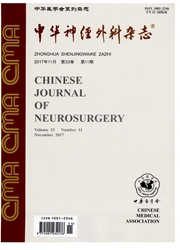

 中文摘要:
中文摘要:
目的采用床突旁动脉瘤的改良分类指导微导管塑形,根据介入治疗结果分析该方法的有效性。方法北京天坛医院神经介入科2009年1月至2011年12月连续介入治疗126例142个囊性床突旁动脉瘤。术前将动脉瘤分为I型(眼动脉动脉瘤)和Ⅱ型(垂体上动脉动脉瘤)。每一类动脉瘤被眼动脉和后交通动脉间的假想等分线分为两类,Ia和Ⅱa是位于等分线的近心端,Ib和Ⅱb是位于等分线的远心端。每一种动脉瘤的分型都有相应的微导管塑形形态,Ia使用直管,Ib使用“S”型导管,Ⅱa使用“C”型(〈90°)导管,Ⅱb使用大弯型(≥90。)导管。塑形后导管的可操作性使用1~5分评级。分析微导管的可操作性与介入治疗效果的关系。结果142个动脉瘤中,有56个(39.4%)动脉瘤属于I型,86个(60.6%)动脉瘤属于Ⅱ型。24个(16.9%)动脉瘤采用单纯弹簧圈栓塞,118个(83.1%)动脉瘤采用支架辅助弹簧圈栓塞。初始栓塞程度:完全栓塞62个(43.7%),瘤颈残留47个(33.1%),部分栓塞33个(23.2%)。各型动脉瘤微导管的可操作性难度为Ib〉Ⅱa〉Ia〉Ⅱb。Ib型动脉瘤微导管的可操作性最差(P〈0.01)。结论改良分类指导的微导管塑形可用于床突旁动脉瘤的血管内治疗。
 英文摘要:
英文摘要:
Objective To develop a modified classification to guide microcatheter shaping in endovascular management for paraclinoid aneurysms and to evaluate the efficiency of this technique. Methods From January 2009 to December 2011, consecutive 126 patients with 142 saccular paraelinoid aneurysms were treated with endovaseular embolization at our institute. Paraelinoid aneurysms were classified as Type I (ophthalmic artery aneurysms) and Type Ⅱ (superior hypophyseal artery aneurysm). Each type was further divided into two subtypes according to their relative position to an imaginary bisector that separated the origin of ophthalmic artery and posterior communicating artery. I a and ]I a referred to aneurysms arising from ICA proximal to the bisector, and I b and lIb referred to those aneurysms arising distal to the bisector. Recommended shapes of microcatheter for each subtype of the aneurysms were I a- straight, I b-S shaped, ]1 a-C shaped ( 〈 90° ) and ]I b-primary curve ( I〉 90° ). The maneuverability of microeatheters was evaluated with an arbitrary score system. Results Of the 142 aneurysms, 56 (39.4%) aneurysms were Type I, while 86 (60. 6% ) were Type Ⅱ. 24 aneurysms ( 16. 9% ) were managed with coil embolization, and 118 (83.1%) with stent-assisted coiling technique. Immediate angiography demonstrated complete occlusion in 62 (43.7%) , neck remnant occlusion in 47 (33.1%) and residual aneurysm occlusion in 33 (23.2%) aneurysms. The mieroeatheter maneuverability scores ranked as I b 〉 Ⅱ a 〉 I a 〉 Ⅱb. The maneuverability of microcatheters in Type I b was the least satisfactory ( P 〈 0. 01 ).Conclusions A modified classification system of paraclinoid aneurysms may be used to guide microcatheter shaping during endovascular treatment.
 同期刊论文项目
同期刊论文项目
 同项目期刊论文
同项目期刊论文
 High Fidelity Virtual Stenting (HiFiVS) for Intracranial Aneurysm Flow Diversion: In Vitro and In Si
High Fidelity Virtual Stenting (HiFiVS) for Intracranial Aneurysm Flow Diversion: In Vitro and In Si Could the types of paraclinoid aneurysm be used as a criterion in choosing endovasculartreatment? Ne
Could the types of paraclinoid aneurysm be used as a criterion in choosing endovasculartreatment? Ne Treatment of symptomatic fusiform aneurysm in basilar artery by stenting following coiling technique
Treatment of symptomatic fusiform aneurysm in basilar artery by stenting following coiling technique Endovascular Treatment of Intracranial Dural Arteriovenous Fistulas Presenting with Intracranial Hem
Endovascular Treatment of Intracranial Dural Arteriovenous Fistulas Presenting with Intracranial Hem Transarterial treatment with Onyx of Cognard type IV anterior cranial fossa dural arteriovenous fist
Transarterial treatment with Onyx of Cognard type IV anterior cranial fossa dural arteriovenous fist Imaging investigation of intracranial arterial dissecting aneurysms by using 3 T high-resolution MRI
Imaging investigation of intracranial arterial dissecting aneurysms by using 3 T high-resolution MRI 期刊信息
期刊信息
